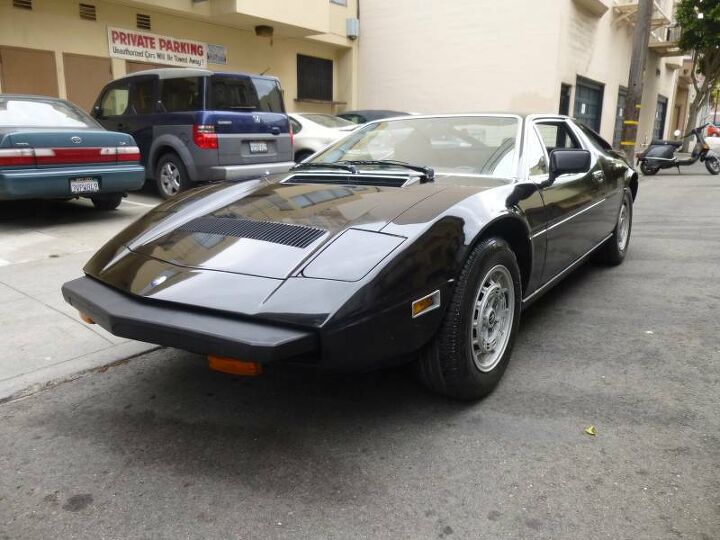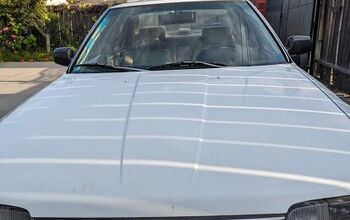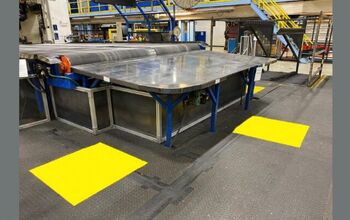Rare Rides: Maserati Merak SS From 1981 - a Seventies Time Warp

We’ve featured a Maserati previously in our Rare Rides series — a bespoke Quattroporte shooting brake which drew mixed styling opinions from the informed and gracious peanut gallery of the B&B. Today though, we step back in time to something closer to the traditional two-door, sporty exotica that makes up much of the brand’s history.
Presenting a Maserati Merak, this one decked out in special SS trim.
The Merak came into being all the way back in 1972, when a struggling Maserati company (oh how things change) found itself under the Citroën corporate umbrella. Carrying many of the same components as the beautiful Citroën SM, the Merak was also similar to Maserati’s Bora. While the Bora was powered by a large mid-mounted 4.7-liter V8, the Merak offered six-cylinder engines of two or three liters of displacement.
The smaller engine allowed the Merak to hold four people of roughly human proportion, rather than two like in the Bora. It also lowered the bottom line, making the Merak the entry level mid-engine model. Perhaps as a result of this lower price, the Merak lived longer than the Bora, which dropped from Maserati’s lineup after 1978.
Soldiering on as the company’s lone mid-engine offering, by the end of the Merak’s life in 1983 Maserati had once again changed owners. In 1975, control passed from Citroën to joint owners De Tomaso and GEPI, a state-owned Italian holding company. A year after the Citroën-backed Merak went away, Chrysler came to purchase five percent of Maserati, and Lee Iacocca was soon busy developing the Chrysler TC by Maserati. Irony knows no bounds.
Back to the Merak. The sporting SS version debuted in 1976, featuring a superleggera-like weight reduction of 110 pounds and an increase in horsepower, from 190 to 220. Power flowed from amidships to rear via just one transmission — a Citroën-supplied five-speed manual.
Aside from the rather awful U.S.-spec bumpers fitted to this later model, other modifications made to the Merak over time improved reliability and practicality. As soon as Citroën passed the ownership torch, engineers at Maserati began removing the complex hydraulic systems its French parents had mandated.
Maserati also designed its own fascia and added more driver-oriented instruments, a more uplevel steering wheel formerly found in the Bora, and replaced the Citroën sun loungers with the company’s own seats.
I’ll always remember the Merak (albeit a fake SS version) as the car Jeremy Clarkson drove in the Top Gear episode with the Budget Super Cars Challenge. Watch it right now if you’ve never seen it, or even if you have.
Maserati produced just 1,000 Merak SS versions, and today’s example is one of just 312 U.S.-spec models. The seller indicates there are just 15,500 miles on the odometer, and adds a list of recent maintenance work that includes carburetor rebuilds. All in all, it’s pretty tidy, and can be yours for $69,500 — which is likely too much money.
[Images via seller]

Interested in lots of cars and their various historical contexts. Started writing articles for TTAC in late 2016, when my first posts were QOTDs. From there I started a few new series like Rare Rides, Buy/Drive/Burn, Abandoned History, and most recently Rare Rides Icons. Operating from a home base in Cincinnati, Ohio, a relative auto journalist dead zone. Many of my articles are prompted by something I'll see on social media that sparks my interest and causes me to research. Finding articles and information from the early days of the internet and beyond that covers the little details lost to time: trim packages, color and wheel choices, interior fabrics. Beyond those, I'm fascinated by automotive industry experiments, both failures and successes. Lately I've taken an interest in AI, and generating "what if" type images for car models long dead. Reincarnating a modern Toyota Paseo, Lincoln Mark IX, or Isuzu Trooper through a text prompt is fun. Fun to post them on Twitter too, and watch people overreact. To that end, the social media I use most is Twitter, @CoreyLewis86. I also contribute pieces for Forbes Wheels and Forbes Home.
More by Corey Lewis
Latest Car Reviews
Read moreLatest Product Reviews
Read moreRecent Comments
- 3-On-The-Tree Tassos, I’m have several different responses yeti your question.[list=1][*] I didn’t buy the corvette for the sole purpose of highway travail, I got it because my dad had a 57 Corvette with 2 four barrel carbs and. 283 V8. I wanted a corvette and a friend who has a custom car performance shop said to get the newest one you could afford.[/*][*]. Letting a car sit is the worst thing for it so it was my daily driver when I was still in the army 30 miles to the base round trip, 160 miles to Tucson form my doctors appointments and VA stuff. My POS 2014 F150 was constantly in the shop for both turbos, two rear main seals, timing chain, transmission. So I was in the process of selling that.[/*][*]But the most important point is that everyone has an opinion and it doesn’t matter what car a person buys or what they use it for.[/*][/list=1]
- EBFlex About time the corpse does something right.I wonder where he got the idea....
- Ajla And in case anyone was interested, yes this tariff does also apply to Polestars, Lincolns, Teslas, Buicks, etc.
- SCE to AUX NPR had an interesting piece on this situation just yesterday, and it turns out that Biden has actually expanded the Trump China tariffs rather than roll them back.However, rather than using the usual shotgun approach employed by past Presidents, Biden's tariff hikes are directed at green/clean energy items which also include non-automotive things such as solar panels.So it looks like the IRA's selective anti-China incentives are part of a larger green agenda, but the plan could backfire if consumers simply choose non-green products instead.Not to mention that it takes gobs of tax money to create the jobs our leaders promise. One calculation put the cost of each new US job created in the solar panel industry at $800k (grain of salt here).Historically, tariffs have been applied after elections, as a reward to those who supported the winning candidate. Of course, this one is happening before the election. Both have political timing, but their economic benefit is doubtful at best, usually injuring the nation who imposes the tariffs.The EU is also getting in on the act, so we could be facing an economic world war over the sourcing of green products. Sadly, if China wasn't an oppressive communist state, we wouldn't even be having this discussion.
- BlackEldo My initial reaction to the interior was "well, they have to leave something on the table to sell the equivalent-sized Lexus." Then I saw the MSRP...







































Comments
Join the conversation
Another one of those "cars linked to family" stories...my sister and I built a plastic model kit of a black Merak years and years ago. I cherished that thing, as it was something we did together. Everywhere I moved, that model was carefully packed up in enough wrapping to secure the Queen of England's crown. For some reason, the car's lines spoke to both of us. Sure, not anywhere near the fastest, most exotic, but a darned fine looking machine. I'll have to send her the link to this article as this looks like "our" model in full 1:1 scale.
I love the instrumentation.